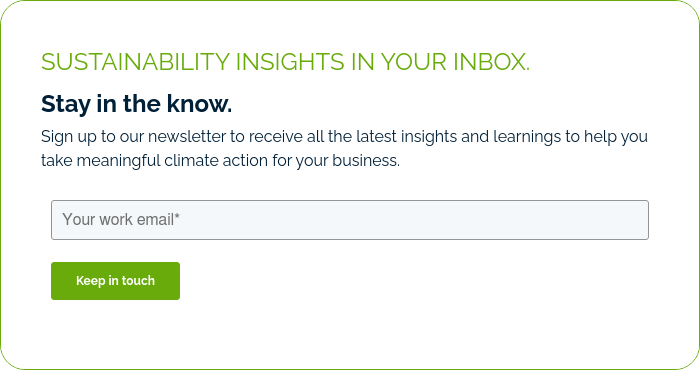Common pitfalls in Scope 3 data collection.
When engaging suppliers for emissions data, it’s essential to avoid some common pitfalls:
- Lack of supplier engagement: Not every supplier will understand why you're asking for emissions data or how to provide it. Without proper context, your request may be ignored or result in poor-quality data.
- Manual tracking: Sending manual follow-ups to hundreds of suppliers is time-consuming and inefficient, especially when you’re juggling deadlines.
- Disjointed systems: Data collected via email or spreadsheet may not integrate smoothly with your existing carbon management system, leading to inefficiencies in tracking and reporting.
Given the volume of upstream and downstream suppliers across your value chain, the task of determining what to include or exclude, engaging with each supplier, obtaining accurate data in a usable format, and consolidating it into a coherent emissions profile is nothing short of daunting.
This complex process requires careful coordination, a robust system for data collection, and clear criteria for what qualifies as relevant emissions data. The scale of this challenge can make the creation of a comprehensive and accurate Scope 3 emissions profile feel like a monumental task.
What to do: Collecting data from suppliers at scale.
After you've conducted a Scope 3 materiality assessment, you'll need to begin the process of engaging with your key suppliers, obtaining accurate data in a usable format, and consolidating this information into a coherent emissions profile.
For some emission sources, suppliers might already have existing reports. For instance, travel agencies can often provide emissions data for flights, or other suppliers may offer reports that include emissions associated with their products or services.
However, you'll need to engage a large pool of key suppliers to gather data. Examples might include sub-contractors on a major construction project or the primary suppliers to a supermarket chain.
In these cases, the most effective method for gathering data is often by designing and sending electronic surveys.
Overcoming obstacles in supplier survey processes.
While electronic surveys are easy to set up and can be scaled across hundreds of suppliers, they do come with potential challenges that should be addressed:
- Supplier engagement: Will your suppliers know how to respond to your survey? It's important to tailor your survey to meet your suppliers where they are in terms of their knowledge and capacity. Providing context, clear instructions, and resources within the survey help guide them to complete it accurately.
- Automation: Manual tracking of responses and follow-ups can be time-consuming. Ensure your survey process is automated to track who has responded and automatically send reminders to those who haven’t.
- Data integration: How will you extract and process the data? The best solutions are integrate directly with your carbon management or ESG reporting software, allowing for seamless data collection and analysis.
How BraveGen SmartForms simplify data collection.
After discussing the challenges in supplier engagement, it’s time to talk about the solution. That’s where BraveGen’s SmartForms come in. They offer an ideal solution to the challenges of collecting Scope 3 data from suppliers at scale.
With SmartForms, organisations can easily gather both qualitative and quantitative data, collect supporting documents, and get signatures for tracking supplier approvals.
It allows you to set up a personalised email to one or a group of similar suppliers to explain the supplier engagement process and data requests. Emails can include imagery and videos to engage suppliers in your ESG journey.
You can automate recurring client data requests at your preferred intervals. This makes it easier to report on and meet your supplier's ESG goals.
Benefits
See the advantages of SmartForms over standard survey forms:
- Automation of email requests: Set up ongoing “tasks” to collect data at regular frequencies (such as monthly) from suppliers.
- Personalisation: Forms capture quantitative and qualitative data fields for broader ESG reporting. Upload supporting docs and accept signatures for audit. Generate common formats as required, save, and clone for similar suppliers. Personalise data request emails to each supplier or supplier type.
- Automatic follow-up email requests: See reports of suppliers who have missed data submissions and set up automatic email follow-ups at desired frequencies.
- Data Quarantine: Review supplier data for accuracy and compare it to previous supplier submissions before approving it for reports and insights by placing it in 'quarantine'.
- In-built Audit Trail: All documents and data are available in a single 'Auditor view'. When questioning or updating supplier emissions, all comments and updates are tracked within the system.
- Integrated Business Intelligence (BI): Visualise your Scope 3 supplier data with automated reports. Track against targets, summarise the impact of top suppliers or visualise emission reductions per supplier. Automate the sending of specific reports to project sponsors or exec teams.
Final thoughts: Turning Scope 3 challenges into opportunities.
Scope 3 reporting is challenging, but it also offers a valuable opportunity. By understanding and mitigating your value chain’s emissions, your business improves its sustainability performance and gains a competitive edge in the market.
It also allows you to identify cost savings through more efficient resource use, uncover operational efficiencies that streamline processes, and foster potential innovations that lead to new products or services.
Additionally, it enhances your brand reputation, builds trust with stakeholders, and ensures compliance with emerging regulations, positioning your company as a leader in environmental responsibility. Embracing Scope 3 reporting can ultimately drive long-term value creation and resilience.
With tools like BraveGen SmartForms, you can turn what feels like an overwhelming task into a streamlined, automated process—giving you more confidence in your data and more time to focus on meaningful climate action.
If you’re interested in learning more about SmartForms, contact us to ask for a demo.


